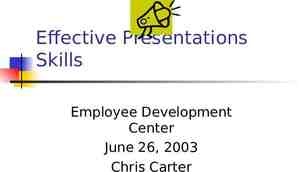Instrumentation Overview: Measuring Caring in Nursing
39 Slides472.29 KB
Instrumentation Overview: Measuring Caring in Nursing
Instrumentation: Defined Process of selecting or developing devices and methods appropriate for measuring an attribute or characteristic of interest Part of the measurement process Elicits data from subjects (participants) or objects
Direct and Indirect Measures of Concept or Construct Direct Measures: straightforward measurement of concrete object Indirect Measures: indicators of concept used to represent abstract concept
Measurement: Defined Rules for assigning numbers to objects to designate quantities of attributes Assign numbers to subjects/participants or objects according to rules Remember: attributes of objects vary day to day, from situation to situation, or from one object to another Variability: numeric expression that signifies how much of an attribute is present in the object Quantification communicates that amount
Relationship between Measurement and Data Collection Measurement Data Collection
Psychometric Instruments and Questionnaires Develop blueprint Theory may be basis of items; achieve theoretical consistency Search literature and connect items to literature Conduct qualitative study on topic: use themes/codes as basis for item development Interview participants knowledgeable on topic; use responses or themes/codes as basis for item development Item stem and distractors (scale) Stem stimulus; Distractor elicits response to item stem
Constructing an Instrument Define the construct Identify items Decide on scale type, e.g., Likert, Rating scale, Yes or No, etc. Create blueprint Item construction, grammar, bias, readability Seek item reviewers (content validity: expert and Content Validity Index for each item) Pilot with subjects/participants representative of population to be tested
Constructing an Instrument Pilot or field test instrument; 10 subjects per item Conduct inter-item or item-item correlations Select items to retain Conduct reliability studies Conduct validity studies Compile norms Publish results of scale development
Instrument Construction Tips Instructions: clear Clarity of items: brief, objective, unambiguous Format of items: simple to complex; balanced Content; group items requiring same response format to avoid confusion Fit instrument to subjects/participants: relevant questions; readability level; length
Questionnaire Items Scales – Ratio level scales scale of 0 to 10 – Likert scales strongly agree, agree, uncertain, disagree, strongly disagree rarely, seldom, sometimes, occasionally, usually (ordinal level) – Semantic differential scales bipolar adjectives with 7-point scale between them (ordinal level)
Characteristics of Levels of Measurement Level of Measurement Characteristic Nominal Ordinal Interval Ratio Distinctiveness yes yes yes yes Ordering in magnitude no yes yes yes Equal intervals no no yes yes Absolute zero no no no yes
Measurement Controversy Treating ordinal scales as interval or ratio may violate a rule, but the outcome is useful Interval or ratio variables can be converted to ordinal or nominal scaled variables Examples Perceived Caring, 1 item, VAS scale: 0 to 100 mm (ratio level) Perceived Caring total score on Likert or rank scaled items (interval level) Perceived Caring item: Likert scale: strongly disagree 1; disagree 2; neither agree nor disagree 3; agree 4; strongly agree 5 (ordinal level) Caring Checklist item: Observed 1; Not observed 0 (nominal level)
Levels of Measurement: Nominal Scale Nominal Scale: Labels for different categories of construct; categorical; discrete data; mutually exclusive, collectively exhaustive dichotomous Examples: Marital status Position on nursing staff Reason for admission Test item response: correct or incorrect Medical diagnosis Surgical procedure Zip code
Levels of Measurement: Nominal Scale Nominal: classify characteristics into categories Gender: 1 Male; 2 Female; 3 Prefer not to respond Age: 1 Young Adult; 2 Middle Aged Adult; 3 Older Adult Group designation Experimental (group exposed to caring curriculum) 1 Comparison or Control (group exposed to standard curriculum) 2
Levels of Measurement: Nominal Scale Patients’ Country Australia Canada Columbia Cyprus Finland Indonesia Iran Ireland Israel Italy Japan Pakistan Philippines Republic of China Thailand United Kingdom United States
Levels of Measurement: Nominal Scale Marital Status Single Married Living with partner Divorced or separated Widowed Employment status Full time Part time Unemployed Disabled Retired Homemaker Student
Levels of Measurement: Ordinal Scale Ordinal Scale examples and order data; ranked series; mutually exclusive, collectively exhaustive, rank ordered Classify General Health Perception 1 Very Good; 2 Good; 3 Fair; 4 Poor; 5 Very Poor Attitude scale: 5 strongly agree 4 agree 3 uncertain 2 disagree 1 strongly disagree Adjectival rating scales: 5 Excellent; 4 Very good; 3 Good; 2 Fair; 1 Poor
Measurement Levels: Ordinal Scale Ordinal Scales categories of variables that can be ordered; distance between categories is unknown socioeconomic status low 1; middle 2; high 3 opinion very poor 1; poor 2; fair 3; good 4; excellent 5 attitude strongly disagree 1; disagree 2; neither agree nor disagree 3; agree 4; strongly agree 5 Bipolar scale (Semantic Differential, bipolar adjectives, 7-point scale) Please check (x) your degree of satisfaction with your nurses as caring on the following scale. Poor Excellent 1 2 3 4 5 6 7
Levels of Measurement: Ordinal Scale 10 9 8 7 6 5 4 3 2 1 0 Certain, practically certain Almost sure Very probably Probable Good possibility Fairly good possibility Fair possibility Some possibility Slight possibility Very slight possibility No chance, almost no chance
Levels of Measurement: Ordinal Scale 6-point scale for Caring Behaviors Inventory versions 1 never; 2 almost never; 3 occasionally; 4 usually; 5 almost always; 6 always 7-pockets (piles of 3 x 5 cards) for 50 items of Care-Q, 7-point scaled items: Example 1 item Most Important (7) 4 items Fairly Important (6) 10 items Somewhat Important (5) 20 items Neither Important nor Unimportant (4) 10 items Somewhat Unimportant (3) 4 items Unimportant (2) 1 item Not Important (1)
Levels of Measurement: Ordinal Scale Ordinal: attributes ordered according to some criterion; sorts objects on basis of their standing on an attribute (e.g., item on instrument) relative to each other Caring Behaviors Assessment (CBA) 5-point Likert-type scale on perceived importance of a behavior 1 Little Importance to 5 Very Important
Delphi Techniques: Start with Themes, Move to Ordinal-Scaled Items Used to measure the judgments of a group of experts, assess priorities, or make forecasts panel of experts identified series of rounds or questions Round 1: start with open-ended items; calculate means and SDs; create second questionnaire; items scaled on ordinal level round 2: present questionnaire with statistics and additional open-ended items; create third questionnaire round 3: present questionnaire with statistics and elicit responses round 4: continues Wolf, Z. R., Freshwater, D., Miller, M., Jones, R. A. P., & Sherwood, G. (2003). A standard of care for caring: A Delphi study. International Journal for Human Caring, 7(1), 34-42.
Levels of Measurement: Ordinal or Ratio Scales Visual Analogue Scale (magnitude scaling) 10 cm line with anchors; situated horizontally or vertically Subject asked to place mark through line to indicate intensity of stimulus Ruler (same one) measures distance from left to right or bottom to top No nurse caring Nurse caring as good as it could be
Measurement Levels: Interval Ordinal Scale Mutually exclusive, collectively exhaustive, rank ordered, at equal intervals Examples CBI-E total scores (ordinal scaled items summed) Mean, 70 to 79 years group 71.05; SD 10.41 Care-Q Monitors/follows through item: Mean 5.04, SD 1.34) Care-Q Anticipates Subscale (patients): Mean 4.47
Measurement Levels: Interval Interval Scales distances between values are equal because there is one accepted physical unit of measurement Total score on Caring Behaviors Inventory-42, 24, and 16 and Caring Behaviors Inventory for Elders: sum of item responses Knowledge test score on elements of nurse theorists formulations: Boykin and Schoenhofer, Erikkson, Halldorsdottir, Locsin, Ray, Swanson, Watson: sum of item responses
Measurement Levels: Ratio Ratio Scale Mutually exclusive, collectively exhaustive, rank ordered, at equal intervals, and with absolute zero Example Caring Nurse Visual Analog Scale some scores of respondents might measure 0 on the 10 cm line
Measurement Levels Ratio Scales zero point Can multiply and divide across a ratio scale 100 Kg is twice as heavy as 50 Kg 10 cm is twice as long as 5 cm
Total Scores on Construct or Concept Test scores are based on test item responses Test items must be articulated precisely and succinctly Items must reflect specific concept or domain of content Carefully crafted items on test are primary method by which skilled test developer reduces error variance (error of measurement), increases test scores’ reliability
Instrument Readability Grade level increases with number of syllables in words of item stems, distractors, instrument directions Various readability formulas available Readability Statistics follow Review, Spelling check procedure Install in computer, open Word: File, Options, Proofing, Show Readability Statistics Readability of Caring Behaviors Inventory for Elders (CBI-E) 4.5 FleschKincaid grade level: included directions, all items, & demographic profile Readability of Caring Behaviors Assessment (CBA) 6th grade level Flesch Readability Formula
Response Rate Important to report as percentage; critique response rate in study limitations Instrument did not include an important alternative or response Subject may have no knowledge or opinion on subject Response rate may threaten sample representativeness even with randomization Stamped, self-addressed envelope Postcard, phone call to remind respondents Email reminders
Overall Description of Instrument Name, Acronym, Author/Creator, construct being measured (conceptual definition); instrument scores generate operational definition Number of items Scaling of items or type of scaling (Q-Sort; Likert; Ranks; VAS, Checklist, etc.) Summing of ordinal items to create total score versus treating items as ordinal scaled data Previous reliability and validity procedures Current study’s reliability and validity procedures Time to administer or complete Person completing
Caring Behaviors Inventory-42 Respectful deference to other (courteous regard for the other) (3,8,1,9,11,2,4,10,7,27,15,28) 12 items; Cronbach’s alpha 0.8906 Assurance of human presence (investment in the other’s need and security) (16,35,37,34,32,36,30,26,33,31,18,29) 12 items; Cronbach’s alpha 0.9221 Positive connectedness (optimistic and constant readiness of the part of the nurse to help the other) (12,25,5,14,13,6,23,21,17) 9 items; Cronbach’s alpha 0.8452 Professional knowledge and skill (proficient, informed and skillful nurse) (19,24,22,38,20) 5 items; Cronbach’s alpha 0.8157 Attentiveness to other’s experience (appreciation of and engrossment in the other’s perspective and experience) (40,39,41,42) 4 items; Cronbach’s alpha 0.8191
Instruments Measuring Nurse Caring Instrument Citation Care-Q Larson (1984) Caring Behaviors Inventory (CBI-42); CBI-24; CBI-6 Wolf, Giardino, Osborne, & Ambrose (1994). Caring Behaviors Assessment Tool (CBA) Cronin & Harrison (1988) Harrison (1988) Hinds (1985) Hinds (1988) Horner (2005) Nyberg (1990) Nkongho (1988) Nkongho (1990) Nkongho (2003) McDaniel (1990) Caring Behaviors of Nurses Scale (CBNS) Professional Caring Behaviors Nyberg Caring Assessment (Attributes) Scale (CAS) Caring Ability Inventory (CAI) Caring Behavior Checklist and Client Perception of Caring McDaniel (2002) McDaniel (2003)
Instruments Measuring Nurse Caring Instrument Caring Assessment Tool (CAT) Caring Assessment Tool-Educational Version (CAT-edu) CAT-admin Peer Group Caring Interaction Scale and Organizational Climate for Caring Questionnaire Caring Efficacy Scale Holistic Caring Inventory Citation Duffy (1992) Duffy (2007b) Duffy (2009) Hughes (1993) Coates (1997) Coates (2009) Reid, Courtney, Anderson, & Hurst (2015) Latham (1996) Pollack-Latham (1991) Caring Dimensions Inventory Watson & Lea (1997) Caring Attributes Professional Self-Concept Technological Influence (CAPSTI) Arthur et al. (1999) Caring Professional Scale (CPS) Swanson (2000) Swanson (2002) Methodist Health Care System Nurse Caring Instrument Sherwood & Shepherd (2002)
Instruments Measuring Nurse Caring Instrument Citation Care/Satisfaction CARE/SAT Larson & Ferketich (1993) Caring Behaviors Inventory for Elders (CBI-E) Family Caring Inventory Wolf et al. (2004) Wolf, Zuzelo, Goldberg, Crothers, & Jacobson (2005) Turkel & Ray (2001) Ray & Turkel (2009) Goff (2009) Nurse-Patient Relationship Questionnaire Quinn, Smith, Rittenbaugh, Swanson, & Watson (2009) Caring Nurse-Patient Interactions Scale Cossette & Pepin (2009). Caring Factor Survey Nelson, Watson, & InnovaHealth. (2009) Relational Caring Questionnaire












































